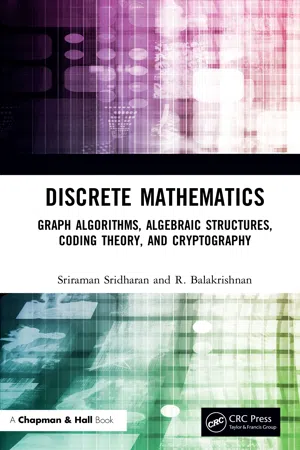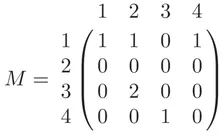
Discrete Mathematics
Graph Algorithms, Algebraic Structures, Coding Theory, and Cryptography
- 314 pages
- English
- ePUB (mobile friendly)
- Available on iOS & Android
Discrete Mathematics
Graph Algorithms, Algebraic Structures, Coding Theory, and Cryptography
About this book
Conveying ideas in a user-friendly style, this book has been designed for a course in Applied Algebra. The book covers graph algorithms, basic algebraic structures, coding theory and cryptography. It will be most suited for senior undergraduates and beginning graduate students in mathematics and computer science as also to
individuals who want to have a knowledge of the below-mentioned topics.
- Provides a complete discussion on several graph algorithms such as Prims algorithm and Kruskals algorithm for sending a minimum cost spanning tree in a weighted graph, Dijkstras single source shortest path algorithm, Floyds algorithm, Warshalls algorithm, Kuhn-Munkres Algorithm. In addition to DFS and BFS search, several applications of DFS and BFS are also discussed.
- Presents a good introduction to the basic algebraic structures, namely, matrices, groups, rings, fields including finite fields as also a discussion on vector spaces and linear equations and their solutions.
- Provides an introduction to linear codes including cyclic codes.
Presents a description of private key cryptosystems as also a discussion on public key cryptosystems such as RSA, ElGamal and Miller-Rabin. Finally, the Agrawal-KayalSaxena algorithm (AKS Algorithm) for testing if a given
positive integer is prime or not in polynomial time is presented- the first time in a textbook.
Two distinguished features of the book are:
- Illustrative examples have been presented throughout the book to make the readers appreciate the concepts described.
- Answers to all even-numbered exercises in all the chapters are given.
Frequently asked questions
- Essential is ideal for learners and professionals who enjoy exploring a wide range of subjects. Access the Essential Library with 800,000+ trusted titles and best-sellers across business, personal growth, and the humanities. Includes unlimited reading time and Standard Read Aloud voice.
- Complete: Perfect for advanced learners and researchers needing full, unrestricted access. Unlock 1.4M+ books across hundreds of subjects, including academic and specialized titles. The Complete Plan also includes advanced features like Premium Read Aloud and Research Assistant.
Please note we cannot support devices running on iOS 13 and Android 7 or earlier. Learn more about using the app.
Information


Table of contents
- Cover
- Half Title
- Title Page
- Copyright Page
- Dedication
- Contents
- List of Figures
- List of Tables
- Preface
- Acknowledgment
- Authors
- Chapter 1: Graph Algorithms I
- Chapter 2: Graph Algorithms II
- Chapter 3: Algebraic Structures I (Matrices, Groups, Rings, and Fields)
- Chapter 4: Algebraic Structures II (Vector Spaces and Finite Fields)
- Chapter 5: Introduction to Coding Theory
- Chapter 6: Cryptography
- Appendix A: Answers to Chapter 1—Graph Algorithms I
- Appendix B: Answers to Chapter 2—Graph Algorithms II
- Appendix C: Answers to Chapter 3—Algebraic Structures I
- Appendix D: Answers to Chapter 4—Algebraic Structures II
- Appendix E: Answers to Chapter 5—Introduction to Coding Theory
- Appendix F: Answers to Chapter 6—Cryptography
- Bibliography
- Index